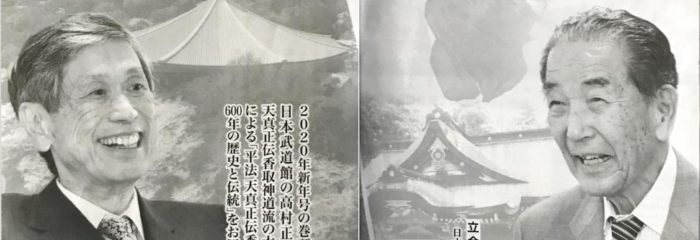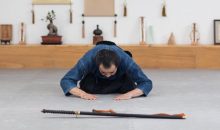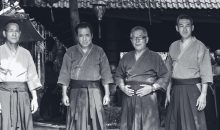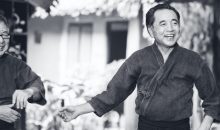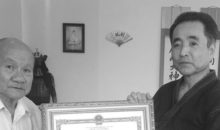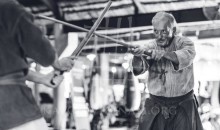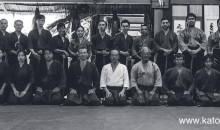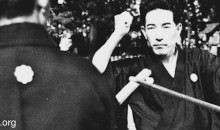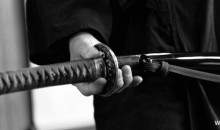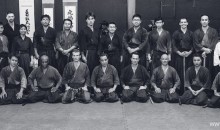Otake Risuke Nippon Budōkan Magazine Interview
Otake Risuke Nippon Budōkan Magazine interview is a translation of the Interview in the January 2020 issue of the Budo monthly magazine published by the Nippon Budokan. We thank Shinbukan Dojo for providing us with the translation. For the original Japanese language version please click here.—————————————————
Otake Risuke Nippon Budōkan Interview 2020
New Year Special Interview: Mastering a Path – 600 Years of History and Tradition of the Art of Peace, Tenshin Shōden Katori Shintō-Ryū
We open 2020 and the new (Reiwa) era’s first issue with an interview between Kōmura Masahiko, Chairman of the Nippon Budōkan and Ōtake Risuke of Tenshin Shōden Katori Shintō- Ryū, “600 Years of History and Tradition of the Art of Peace, Tenshin Shōden Katori Shintō-Ryū”.
Present were Ōtake Risuke, Tenshin Shōden Katori Shintō-Ryū, Mifuji Yoshio, Executive Director, Nippon Budōkan and Kōmura Masahiko, Chairman, Nippon Budōkan.

Ōtake Risuke
Born Taishō 15 (1926). In Shōwa 17 (1942), he entered Tenshin Shōden Katori Shintō-Ryū under Hayashi Yazaemon Iekiyo at 16 years of age. In June of Shōwa 35 (1960), the school was designated a Chiba Prefecture Intangible Cultural Asset. He was appointed guardian of the tradition. Besides this, he worked as a Chiba Prefectural Swords and Firearms Registration Examiner over a period of 30 years. Due to his achievements as a guardian of an Intangible Cultural Asset and in the sword industry, he received an Award for Regional Achievements from the Minister of Education. In the spring of Heisei 17 (2005), he was awarded the Order of the Rising Sun, Gold and Silver Rays.

Kōmura Masahiko
Born Shōwa 17 (1942). He was first elected as a member of the House of Representatives in Shōwa 55 (1980), and was elected a total of 12 times. He was the Heisei 10 (1998) Minister for Foreign Affairs, Heisei 12 (2000) Minister of Justice, Heisei 19 (2007) Minister of Defence, and Heisei 19 (2007) Minister for Foreign Affairs. He was the Vice President of the Liberal Democratic Party from Heisei 24 (2012) to Heisei 30 (2018). Within the Nippon Budōkan, he served as Auditor from Heisei 8 (1996) to Heisei 16 (2004), as Executive Director from Heisei 16 (2004) to Heisei 19 (2007) and Heisei 21 (2009) to Heisei 29 (2017) Executive Director, after which he assumed office as Chairman in Heisei 29 (2017). He also currently serves as Chairman of the Council for Japanese Martial Arts, Council for All-Japan Prefectural Budōkan, and the Nihon Kobudō Association.
Otake Risuke Nippon Budōkan: The Origins of Tenshin Shōden Katori Shintō-Ryū
Kōmura: Today we have invited Ōtake Risuke-sensei from Tenshin Shōden Katori-Shintō Ryū for the Budō monthly magazine’s interview with the chairman of the Nippon Budōkan.
Ōtake-sensei, thank you for coming despite having a hard time dealing with the damages from Typhoon No. 15 (Faxai).
Ōtake: Likewise, thank you for having me. I was surprised when I first heard about doing an interview with you, Kōmura-sensei. I was nervous about what I could talk about.
Kōmura: There are lots of things I want to ask you. I’m looking forward to this. How old are you now, Ōtake-sensei?
Ōtake: I will be 94 soon.
Kōmura: I see, you look very healthy and well for your age. I hear you still teach and train at the Dōjō. That is wonderful.
Ōtake: You are too kind. I do it because I believe that it is my mission to transmit Katori Shintō- ryū to future generations.
Kōmura: To start off with, can you tell me about the origin and history of Tenshin Shōden Katori Shintō-ryū?
Ōtake: Yes. The founder was Lord Iizasa Chōisai Ienao. He was born about 630 years ago in 1387. Lord Ienao was known for his martial prowess as a retainer of the Chiba clan. His masters, the Chiba clan later fell into ruin. It was an era where simple manpower could not influence the rise and fall of provinces and clans. Lord Ienao was in his sixties when he realised this and entered Buddhist monkhood, adopting the name Chōisai and living in seclusion within Katori Jingū.
Kōmura: He lived in seclusion within the shrine grounds of Katori Jingū?
Ōtake: Yes, Lord Ienao believed in the divine might of the deity of Katori Jingū, Futsunushi-no-Ōkami.
Kōmura: Speaking of Katori Jingū, it is an ancient shrine dedicated to a god of war. Its deity, Futsunushi-no-Ōkami, played a large role in the Kuni-yuzuri of Japanese mythology. Since ancient times, many martial artists would visit Katori. Even Dōjōs nowadays worship the deities of Katori and Kashima.
Ōtake: Indeed, it is as you have said. In the past, Sakimori (Ancient soldiers of Eastern Japan sent to Kyushu to defend against the invasion of the Chinese and Koreans.) learnt martial arts and offered prayers at the Katori and Kashima shrines. This was called Kashima-dachi (An expression meaning ‘to go on a journey’.)
Kōmura: Ah yes, there is the expression “Kashima-dachi”.
Ōtake: Lord Ienao prayed to the deity of Katori for a thousand days and nights. As a result of his training, it is said that he received the revelation “thou shalt become the master of all swordsmen under heaven” and a divine scroll from the deity of Katori. This is the true transmission by Futsunushi-no-Ōkami, and is said to be the origin of “Tenshin Shōden Katori Shintō-Ryū”.
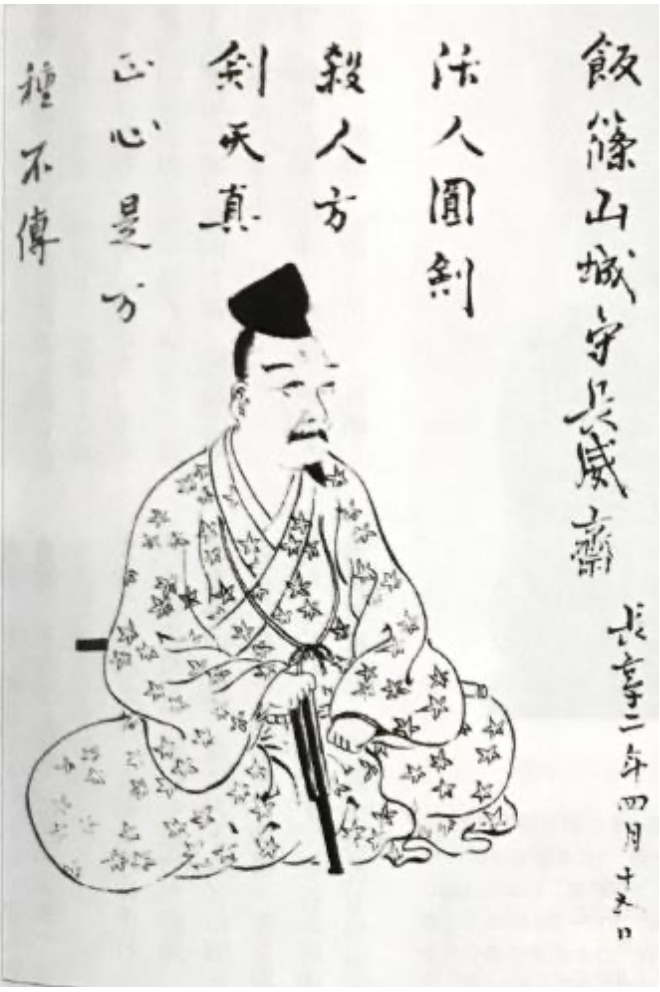
Otake Risuke Nippon Budōkan: 630 Years of History and Tradition
Kōmura: So there has been 630 years of history and tradition since the founder, Lord Ienao. As a comprehensive martial art, it can be called the oldest school of Japanese classical martial arts.
Ōtake: Yes, it is as you say. The Iizasa family has inherited Katori Shintō-ryū generation after generation since the founder, Lord Ienao. I truly think it is precious that the tradition has continued for 630 years.
The Sōke of our school have for generations said “the eldest son shall serve no master”. This is because when you pledge your sword in the service of a master, there will come a time when you will be ordered to cut down another and take their life. Disobey your orders, and you are treacherous. Fulfil your duty on the other hand, and you are unrighteous. Relatives of the one who was cut down will hold a grudge and be unable to walk the path of integrity.
Kōmura: That is precisely Taira no Shigemori’s “In being loyal to my master, I betray my family. In being loyal to my family, I betray my master.”( Famous words by Taira no Shigemori when forced to choose between Emperor Go-Shirakawa and his father, Taira no Kiyomori.), except “In being loyal to my master, I betray what is right.”
Ōtake: Yes. In the Buddhist scripture called the Uppakilesa Sutta, it says “Animosity cannot be quelled by animosity. Animosity can only be quelled by lack of animosity. This principle transcends all time.” In Katori Shintō-ryū, the teachings of Shintōism, Confucianism, and Buddhism are still very much alive. These teachings that have been passed from one generation to the next are the reason why our school’s 630-year tradition have continued for 20 generations.
Kōmura: I see. I hear that many master swordsmen have studied Katori Shintō-ryū.
Ōtake: That is correct. Apart from master swordsmen such as Kami’izumi Ise-no-kami Nobutsuna, the founder of Shinkage-ryū, Tsukahara Tosa-no-kami Bokuden of Kashima, Matsumoto Bizen-no-kami Masanobu, and Moro’oka Ippasai, Toyotomi Hideyoshi’s famed strategist Takenaka Hanbei Shigeharu was also part of our school. Katori Shintō-ryū has influenced many schools of Kenjutsu.
Kōmura: So it is the source of early modern Kenjutsu.
Ōtake: Yes. It is said that of the students of our school, none has ever cut another down, and none has been cut down by another. This is also the Gokui (essential teaching) of Heihō, the art of peace – the art of leading a peaceful life. However, this doesn’t make for good dramas or novels (laughs).
Kōmura: I see, I see (laughs). Still, I think that is a most noble thing.
Wartime, Joining the Tradition in Search of Discipline
Kōmura: Now, Ōtake-sensei, could you please tell us about how you joined Katori Shintō-ryū?
Ōtake: I joined Katori Shintō-ryū in November of Shōwa 17 (1942). I was 16 years old. It was a very turbulent period of time where the Mukden Incident, the February 26 Incident, and the Second Sino-Japanese War all happened one after the other. I was raised being told by my mother, “The name ‘Risuke’ uses the same character as General Nogi Maresuke. Also, the characters ‘Risuke’ and ‘Maresuke’ have the same number of strokes, so you must become as great as General Nogi, okay?”.
At the time we were taught that “when Japanese men die on the battlefield, they must die saying “Long live (Banzai) the Empire of Japan!” with a smile on their face.” However, I heard that “in actuality, soldiers would say “mother, mother” and take their last breaths while calling out names of their family.” After this, I felt that “I want to be someone that can willingly sing Banzai for my country” and thought I had to discipline myself.
Kōmura: It was such a turbulent time, yet you had such great resolve.
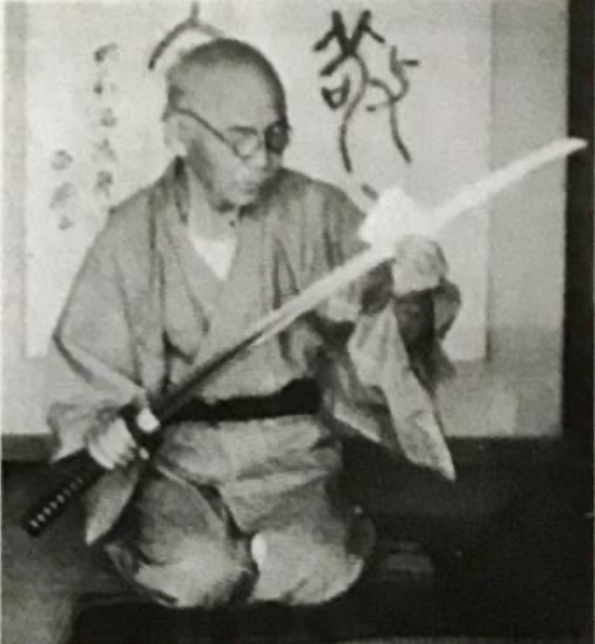
Ōtake: I knew that there was a teacher of a martial art called Katori Shintō-ryū about 4 km from my home and entered the school with my friend.
Kōmura: That must be Hayashi-sensei.
Ōtake: Yes. I joined under Hayashi Yazaemon-sensei. I signed a pledge saying, “Thou shalt refrain from revealing the teachings of our school to their parents, children, and peers”, did the Keppan (blood oath), and began my training.
Kōmura: I see. Ōtake-sensei, you have consistently held the warrior resolve to “be someone that can willingly sing Banzai” as you just said, but you also occasionally write poems. These poems lay bare your affection towards your parents and your family. You are the owner of great martial resolve and a warm compassion. After the war ended and your older brothers were discharged from the military, you wrote this poem:
“Three boys come home together. The faces of my parents who rejoice and forget we lost the war”.
Ōtake: You are too kind. I hardly deserve such words of praise by you, Kōmura-sensei.
Training Every Night in Former Teacher, Hayashi Yazaemon-sensei’s Garden
Kōmura: How and what did you train when you first joined the school, Ōtake-sensei?
Ōtake: Well, Hayashi-sensei was a farmer and was busy during the daytime, so training was in the night time. From when the rice harvest ended in September to the spring equinox, I trained every night in sensei’s garden. We relied on moonlight, and when the moon wasn’t out, we trained by hanging oil lamps on the veranda.
Kōmura: Wasn’t it hard to train outside in the winter?
Ōtake: Even when it was cold enough for frost columns to form outside, we trained barefoot. On nights when it was windy and the lamp goes out, we practiced Iaijutsu and Jujutsu in his house. Sometimes we would listen to sensei’s lectures on Budō.
Kōmura: I see. Eventually, Ōtake-sensei, you received military draft orders, yes?
Ōtake: Yes. I enlisted in June of Shōwa 20 (1945), and my military service ended in two and a half months. After the war ended, for about two years, martial arts were outlawed. I practiced at night alone in secret while recalling the Kata of Katori Shintō-ryū. Hayashi-sensei told me, “There is nothing that can do you more good than practicing alone.” I always thought hard of these words while I trained. I received Mokuroku in January of Shōwa 24 (1949), and Menkyo in January of Shōwa 27 (1952).
Kōmura: Hayashi-sensei played a large role in connecting Katori Shintō-ryū with modern times. He spearheaded its revival.
Ōtake: Hayashi Yazaemon Iekiyo-sensei joined Katori Shintō-ryū when he was 15 years old. During the day he cleared forests for cultivation, and during the night he made charcoal. He was such a hardworking person that in between he would walk some 20 km at night to the Dōjō for training. After that, he furthered his training with Yamaguchi Kumajirō-sensei, one of the best students of the 18th Sōke, Iizasa Morisada.
In Shōwa 5 (1930), he performed a demonstration at a competition attended by the imperial family held at the imperial palace’s Saineikan Dōjō.
This demonstration was seen by many top martial artists of the day who participated in the competition such as Nakayama Hakudo-hanshi, Sonobe Hideo-hanshi, as well as Kendo practitioners such as Miyazaki Mosaburō, Noma Hisashi, Nakajima Gorozō, and Haga Jun’ichi.
Kōmura: They were all very prominent martial artists.
Ōtake: Hayashi-sensei, of course with his skill as a Gokui Kaiden holder of Katori Shintō-ryū, but also with his gentle and sincere character, was loved by his students as if he were the most affectionate father.
He was also the one who fixed the writing of “Shintō-ryū”. Depending on the era and literature, “Shintō-ryū” was also written as 神刀流 (school of the divine sword), or 神当流 (school of the divine strike). Hayashi-sensei played a central role in unifying the writing of “Shintō-ryū” as 神道流 (school of the way of deities), which was used in the days of the founder. Sensei lived out his 82 years of life in Shōwa 39 (1964).

Otake Risuke Nippon Budōkan: Katori Shintō-ryū Becomes a Prefectural Intangible Cultural Asset
Ōtake: Hayashi-sensei was also central to the designation of Katori Shintō-ryū as an Intangible Cultural Asset of Chiba Prefecture.
I once demonstrated the Iaijutsu of Katori Shintō-ryū at an exhibition held by the Society for the Preservation of Japanese Art Swords. For this demonstration, I obtained permission from Hayashi-sensei to perform Iaijutsu with a sword made by Osafune no Sukesada. The chairman of the East Chiba branch of the society was so impressed by the demonstration that he told me “Our country has not designated a martial art as cultural asset yet, but let’s apply for Katori Shintō-ryū to become a Chiba Prefectural Intangible Cultural Asset”. Hayashi-sensei introduced and explained Katori Shintō-ryū to members of the Chiba Prefectural Cultural Asset Advisory Committee and filed an application in Shōwa 33 (1958).
Kōmura: I hear that you went through an amazing episode at this time.
Ōtake: Following the application, the department in charge of Chiba prefecture came to us with a suggestion, “What is Katori Shintō-ryū? If it is really a martial art, then you should have a duel with someone like a young 5th dan Kendo practitioner.”
Kōmura: That was quite the outdated and violent suggestion to make (laughs).

Ōtake: For generations, our school has prohibited duels. Hayashi-sensei was conflicted between withdrawing the application, or accepting the duel because it was a chance to make Katori Shintō-ryū known to the world. I was to participate in the duel, and Sensei taught me the “Oku no Gokui” (Innermost essential teachings) of our school. I desperately swung my Bokken every night in preparation for the duel. In the end however, the duel was cancelled due to a decision made by the department in charge of Chiba prefecture.
Kōmura: That must be because of Heihō – to achieve victory without conflict, the teaching of Katori Shintō-ryū. The spirit of these teachings must have gotten through to them.
Ōtake: You are too kind. Hayashi-sensei was so glad he teared up and said, “This is the true essence of Katori Shintō-ryū. Your exceptionally strong will has reached the founder.” That year, I received the Gokui Kaiden scroll and a proof signifying that I have attained Gokui Sōden from Hayashi-sensei. Sensei told me, “Call yourself Gokui Kaiden once you are 42 years old.” At the time I was 32 years old, so I think it was to be in accordance with the rules of our school. Then, in June of Shōwa 35 (1960), Tenshin Shōden Katori Shintō-ryū was officially designated Intangible Cultural Asset of Chiba Prefecture.
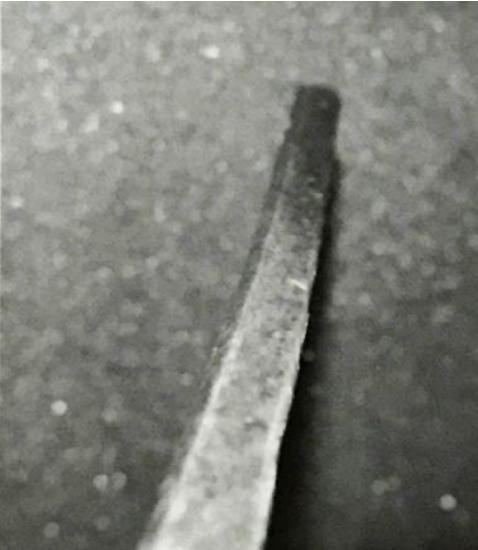
Kōmura: That was the first time a martial art has been designated Intangible Cultural Asset in our country. That is truly wonderful. Currently, the Nippon Budōkan and Nihon Kobudō Association are working towards making Kobudō which are Intangible Cultural Assets into National Cultural Assets.
Every year, the Assembly for the Promotion of Martial Arts is held by the Parliamentary Association for Martial Arts, the Council for Japanese Martial Arts, and the Nippon Budōkan. Clause 6 of the Resolutions adopted in the Heisei 31 (2019) session states, “In striving for the preservation and inheritance of Kobudō which possesses one thousand and several hundred years of history and is the source of modern Budō, we hereby define ‘Kobudō’, a term that our country boasts to the world, within the Cultural Properties Protection Law
We will take necessary measures and provide the required support in order to promote the designation of Kobudō around the country as cultural assets.” This is the first time such an implementation has been requested to the government. Once the term ‘Kobudō’ has been defined in the Cultural Properties Protection Law, the prospects for the future will be bright. The Heisei era was an era for the revival of Budō. I hope that the new Reiwa era will be an era for the revival of Kobudō.
Ōtake: I am very grateful for that. I look forward to it and appreciate all the work you put in, Kōmura-sensei.
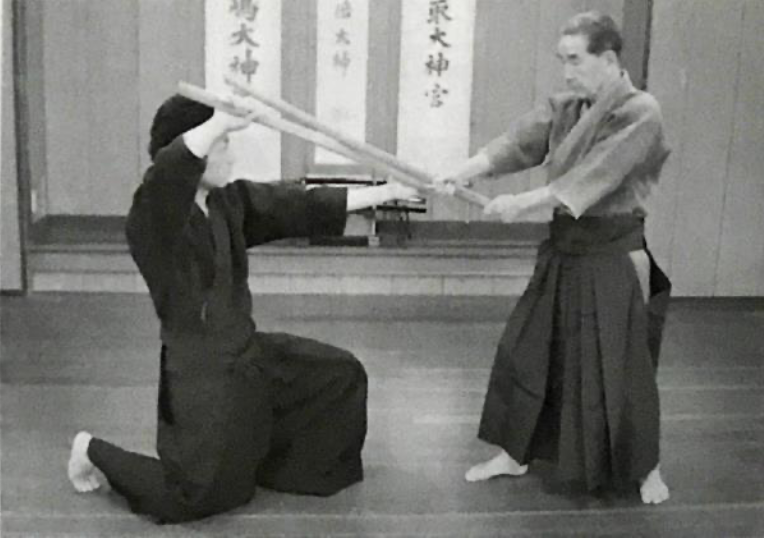
Otake Risuke Nippon Budōkan: The Long Kenjutsu Kata of Katori Shintō-Ryū
Kōmura: Katori Shintō-ryū, which can be said is the source of modern Budō, contains not only Kenjutsu, but also Iaijutsu, Bōjutsu, Naginatajutsu, Sōjutsu, and even Jujutsu, correct?
Ōtake: Yes. It is a martial art that survived the warring states period, so it can even be called a comprehensive martial art. We also have Shurikenjutsu and the study of strategy and warfare.
Kōmura: I see. Please tell us more about the characteristics of Kenjutsu.
Ōtake: Yes. The Kenjutsu kata are designed to be lengthy, the likes of which are not seen in any other school.
Kōmura: Indeed. I have seen the demonstrations at the Nippon Kobudō Enbu Taikai in the Budōkan. Each kata is very long and the techniques seem very complicated. There are many schools such that the older the martial art, the simpler the techniques and movements, so it left a vivid impression on me when I first saw it.
Ōtake: Kōmura-sensei, you are also a martial artist, so your observations are very astute. I am impressed. The kata are long so that the essential teachings cannot be stolen, and to increase stamina to prevent breathlessness on the battlefield. Also, there are parts of the kata where the opponent’s sword is received, but in reality these are all techniques where you evade and cut the opponent. It is designed so that one cannot grasp this by simply looking at the kata.
Kōmura: I see. That is very deep.
Ōtake: It is said that Budō begins and ends with respect. Observation of this is especially important in Iaijutsu. Before the war, all practice was done with real swords, not imitation swords. As you practice, there are times when one will unconsciously start to develop bloodlust and lose oneself. As such, it is most important in Iaijutsu to be able to maintain a sense of respect.
Kōmura: Practice before the war was with real swords? I can almost feel the tension in the air.
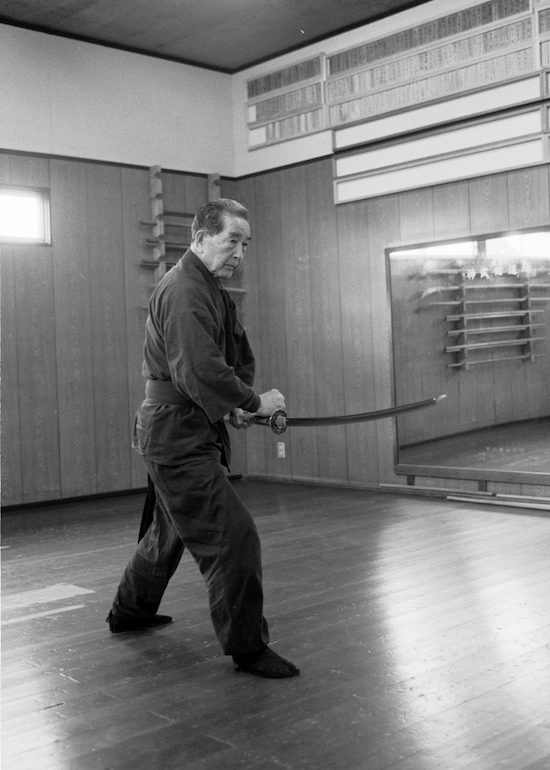
Ōtake: Before you sheathe your sword, you perform chiburi (The act of shaking blood off the blade.). The chiburi of our school is unique in that after pulling the sword towards our body, we spin the sword once while in stance, and strike the hilt with our right fist. I believe that rather than an actual chiburi, its purpose is to serve as a pause between each technique and to heighten concentration.
Kōmura: I see. By the way, Katori Shintō-ryū also contains Jujutsu, yes? I mean, if you lose your weapon on the battlefield and can’t do anything then you can’t really be called a martial artist, can you? I have heard of a teaching that says “when your sword breaks and you have fired your last arrow, grapple.”
Ōtake: Indeed. The Jujutsu of Katori Shintō-ryū is structured such that the Omote (outer) techniques are grapples and throws, while the Ura (inner) techniques are joint locks. There are many dangerous techniques, so only Menkyo and above learn Jujutsu. I heard that when Kanō Jigorō-sensei from Judo visited Katori Jingū, my teacher Hayashi-sensei performed a demonstration. Even in his later years, Kanō-sensei was said to have wanted to turn Judo into a comprehensive martial art including both strikes and weapons. I have heard that a peer of Hayashi-sensei accepted a request from Kanō-sensei to teach at the Kōdōkan.
Kōmura: I see. It is said that Kanō-sensei held the idea that Judo should be a martial art, not a competitive sport. I have read in a book that he sent one of his best students to study Aikido under the venerable Ueshiba Morihei.
Otake Risuke Nippon Budōkan: The Deeply Emotional “600th Anniversary for the Birth of the Founder”
Kōmura: The “600th Anniversary for the Birth of the Founder” in Shōwa 62 (1987) was truly an undertaking to be celebrated for the school. I’m sure you went through a lot.
Ōtake: We celebrated the “600th Anniversary for the Birth of the Founder” in Shōwa 62 (1987), 600 years after the founder Lord IIzasa Chōisai Ienao was born in Genchū 4 (1387). I faced this task understanding that it was the biggest mission of my lifetime.
Commemorative events included the maintaining of the founder’s grave, the repairing of the Hall of Marishiten and the Dōjō, and the publishing of a memorial magazine. On May 10th, we held the “Commemorative Demonstration for the 600th Anniversary for the Birth of the Founder”. Including our school, 20 schools of martial arts participated in this commemorative demonstration. Many people attended the event and I performed Iaijutsu. The commemorative demonstration was a great success, and it was a deeply emotional day for me. Even now, I remember it just like it was yesterday.
Kōmura: You also wrote about this in your book, but the congratulatory addresses in the opening ceremony of the anniversary were wonderful. Iizasa-sōke said, “Our school holds the privacy of its teachings in high regard. In doing so, we arrive at today having upheld the principles of ‘seek no opponent, reject no visitor, pursue no leaver.”
In their addresses, the guests said, “The founder taught that ‘The art of war is the art of peace’. ‘One who prevails over his opponent without force is superior to one who strikes his opponent down’.” Another said, “The founder, seeking order within martial arts, received divine teachings from the founding deities and opened his eyes to Budō. It is remarkable that today, 600 years later, the very same Budō continues to have questions to ask of people. The tradition is very much alive in the inheritance of both its sprit and form.”
Ōtake: Precisely. The two guest addresses were given by an honorary member of the anniversary committee and the head priest of Katori Jingū.
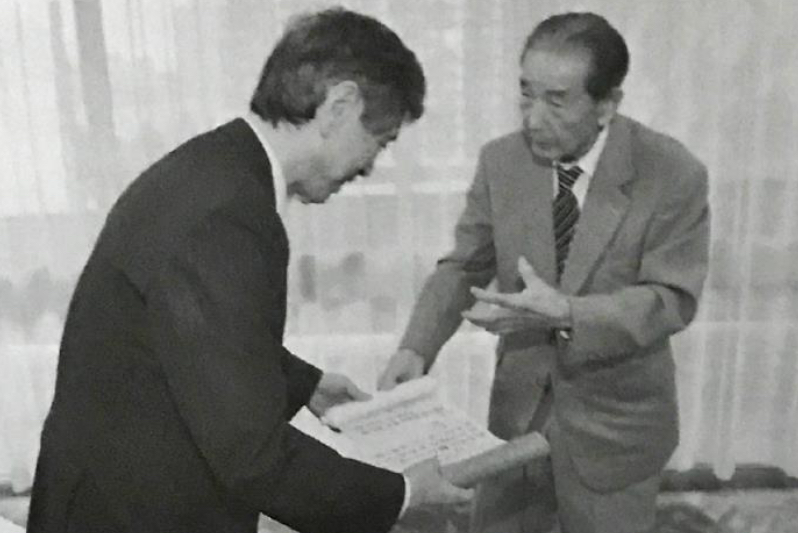
Otake Risuke Nippon Budōkan: Heihō, the Essential Teaching of Katori Shintō-Ryū
Kōmura: I would like to ask you about ‘Heihō’ which has already come up a few times in our discussion. Normally, in martial arts and Budō, one aims to study ‘Heihō’, 兵法 (the art of war) in order to become a peerless warrior. To aim for ‘Heihō’, 平法 (the art of peace) is not something you see in other schools, correct?
Ōtake: Yes. As the beginning of the Mokuroku scroll of our school states, “To begin with, the art of war is the root of the Confucian way. Therefore, the art of peace is profound. A man must not be ignorant of the art of peace. To prevail over an opponent without drawing one’s sword is the foundation of Shintō-ryū.” As such, to achieve victory without conflict, that ‘man should live life in peace as man does’, is the teaching of Heihō in our school.
The essential teachings of Katori Shintō-ryū does not lie in just the use of swords, weapons, and physical techniques, but also within the ideology of the art of peace itself.
Kōmura: For quite a while after our country lost the war, idealistic pacifist opinions such as “deterrence is unnecessary in maintaining peace” dominated. However, a country with no self- defence capabilities cannot realistically hope to keep the peace. I think there are similarities between deterrence as a means of maintaining self-defence and the Heihō of Katori Shintō-ryū.
Ōtake: It is as you have said. Heihō, the art of peace, is unattainable without comparable strength. There is a famous anecdote about the founder Lord Ienao that is used to pass on the teaching of Heihō.
Otake Risuke Nippon Budōkan: The Teaching of ‘Sitting on Kumazasa’, Removing Your Opponent’s Will to Fight
Ōtake: Yes. It is a story that has been passed down for a long time in our school. It goes like this: When challenged to a duel by students of other schools, the founder would lay a mat on top of some Kumazasa (a type of Japanese bamboo leaf.) and sit on top of it. He would then invite his opponents to replicate his feat, “if you can sit on top of the Kumazasa like I have, then I will face you”. The opponent saw that the Kumazasa the founder was sitting on neither bent nor buckled, as if the founder was floating in mid-air. Sensing the difference in strength, the challenger lost the will to fight and withdrew. However, another lesson to be learned is that this is no easy feat.
Kōmura: I’m sure only those who have gone through blood-sweating training can accomplish such an achievement. After hearing you talk about this teaching of Heihō, I’m convinced that it shares the same idea as “going from idealistic pacifism to realistic pacifism” that I often talk about. It is necessary to train and prepare, but one will not fight.
Ōtake: Indeed.
Kōmura: After the war ended, at the 1951 San Francisco Peace Conference, there were calls to “banish Japan from international community.” When this happened, J. R. Jayewardene, the then-Minister of Finance who represented Ceylon, gave a speech that lead to the demand for Japan to pay war reparations being dropped. Citing Buddhist scriptures, he said, “Face grudge with even more grudge, and the grudge will last forever.” I think this is precisely the teaching of Heihō itself.
Ōtake: Ah yes, that did happen.
Kōmura: Animosity only breeds more animosity, and will lead to endless conflict. If I recall, that was from the Buddhist scripture of Dhammapada. It is exactly what you said in the beginning, Ōtake-sensei.
In my first year as a member of the National Diet, I met Mr. Jayewardene. This was after he became President of Sri Lanka. He donated his eyes when he passed away. His left eye was received by a Japanese person because he wrote in his will that he wished to “donate his right eye to a Sri Lankan, and his left eye to a Japanese person”. He was very much a Japanophile. Because I respect Mr. Jayewardene so much, I took on the role of President of the Parliamentary Association for the Friendship between Japan and Sri Lanka.
Ōtake: I see. That was a fantastic story.
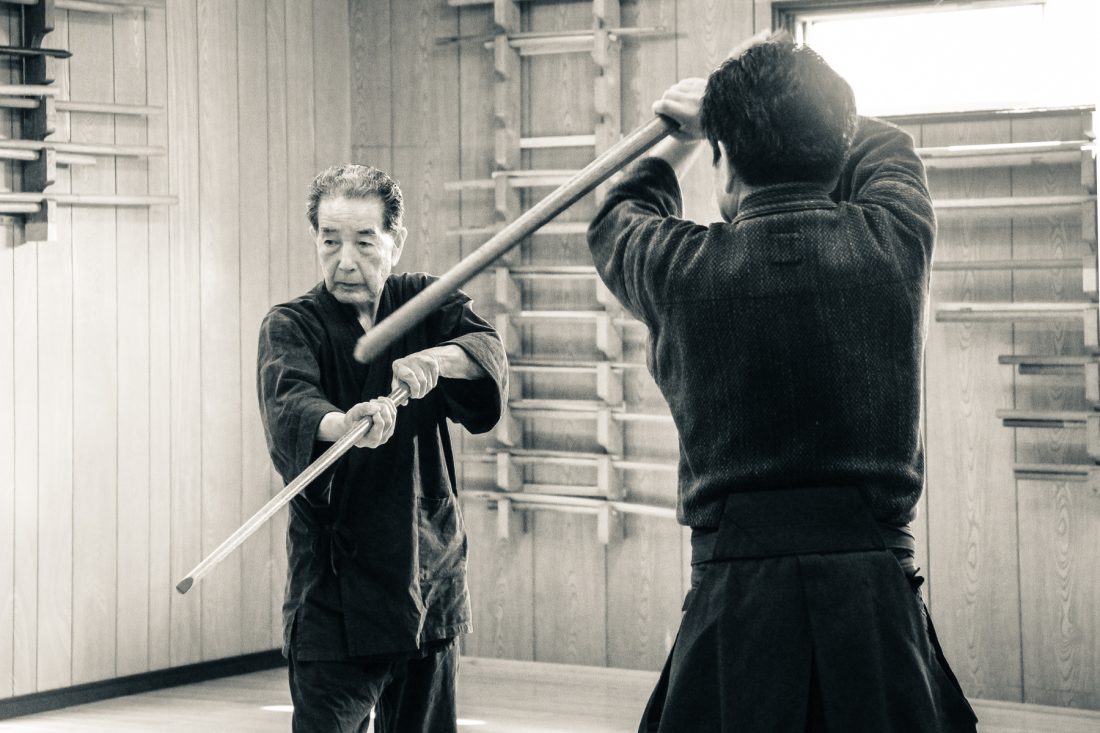
Otake Risuke Nippon Budōkan: Foreign Practitioners from 52 Countries Around the World Come to the Land of Katori
Kōmura: I hear that even nowadays, there are foreign practitioners from Russia and Brazil that come to study at the Dōjō.
Ōtake: Yes. Up to now, practitioners from 52 countries around the world have come to the Dōjō of Katori Shintō-ryū. Our Dōjō has a lot of office workers, so there is practice 3 times a week, in the afternoon and evenings of Tuesday, Thursday, and Saturday. However, after seeing many people from abroad spending large sums of money to travel and stay at hotels just to train at our Dōjō, I was moved by their passion. Now I tell them “you can come to practice every day.”
Kōmura: Do students from abroad also have to sign the keppan?
Ōtake: Yes, they do.
Kōmura: I see. They properly follow traditions passed down since ancient times. The book that you wrote, Ōtake-sensei, which was published by the Nippon Budōkan, “Strategy and the Art of Peace – Tenshin Shōden Katori Shintō-Ryū”, has received positive reviews from many readers and we are in the process of printing more copies. The English version that was published afterwards has also been widely read around the world and I hear that more copies are being printed too. Ōtake-sensei, you have left a lasting legacy in terms of cultural exchange as well.
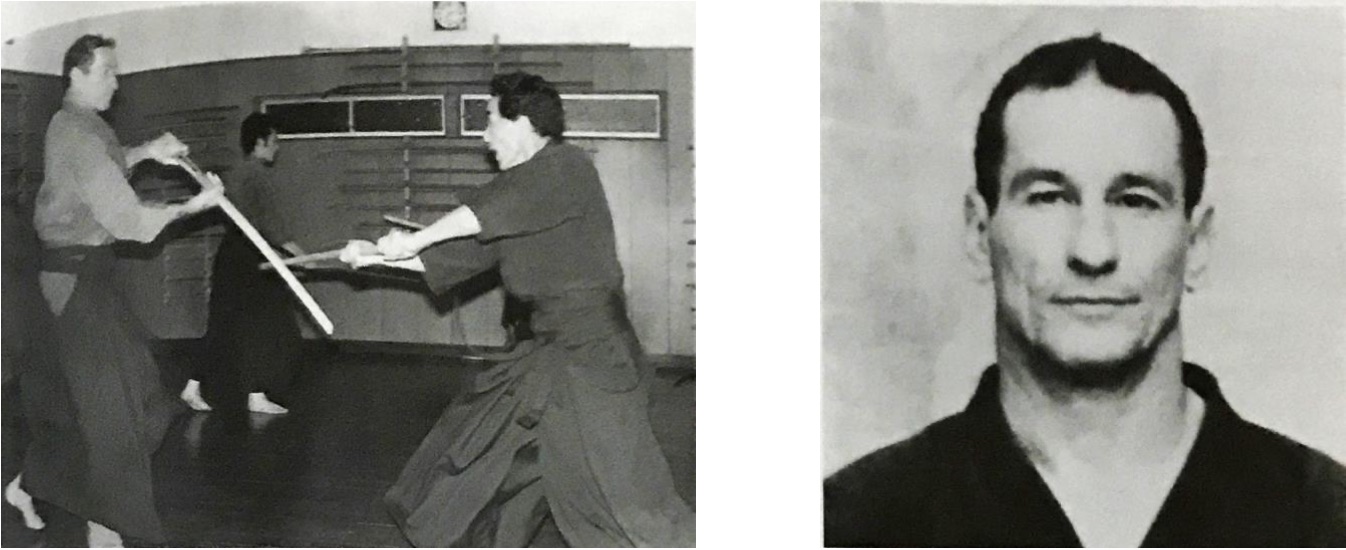
Otake Risuke Nippon Budōkan: Memories of Donn Draeger
Kōmura: Speaking of foreign practitioners, Mr. Donn Draeger was foreign practitioner no. 1, correct?
Ōtake: Yes. He joined in April of Shōwa 41 (1966). Donn Draeger was 44 years old at the time. He was visiting martial artists around Japan for his martial arts research. When he joined at first he came from Tokyo, but he later moved to Narita to devote himself to practice. Even in that time Mr. Draeger often travelled the world for his martial arts research. His passion was splendid and I granted him the Menkyo scroll in Shōwa 49 (1974).
Kōmura: Mr. Draeger played a significant role in introducing Japanese martial arts to the world.
Ōtake: Very much indeed. He was a benefactor of Japanese martial arts. I have many memories with Mr. Draeger. In May of Shōwa 55 (1980), we spent 50 days touring Europe giving talks and performing demonstrations. At the time he was contemplating the idea of building a martial arts museum in Hawaii.
Kōmura: Really?
Ōtake: In Shōwa 57 (1982), he passed on to heaven while receiving treatment for a disease in his hometown. He was 61 years old when he passed. I couldn’t stop crying when I received news of his death. Mr. Draeger was more respectful and courteous than even the Japanese people. He was a man of excellent skill and insight into the martial arts.
Once, he asked me, “Isn’t there something deeper hidden within the kata of Katori Shintō-ryū?” I was impressed that he was so perceptive. We talked about the Kenjutsu kata and I told him, “whenever you receive, you actually are evading and cutting the opponent”. This is called ‘Kuzushi’, but Mr. Draeger had already recognised its existence. When I taught him about ‘Kuzushi’, he was deeply moved and said they were “techniques beyond human comprehension”.
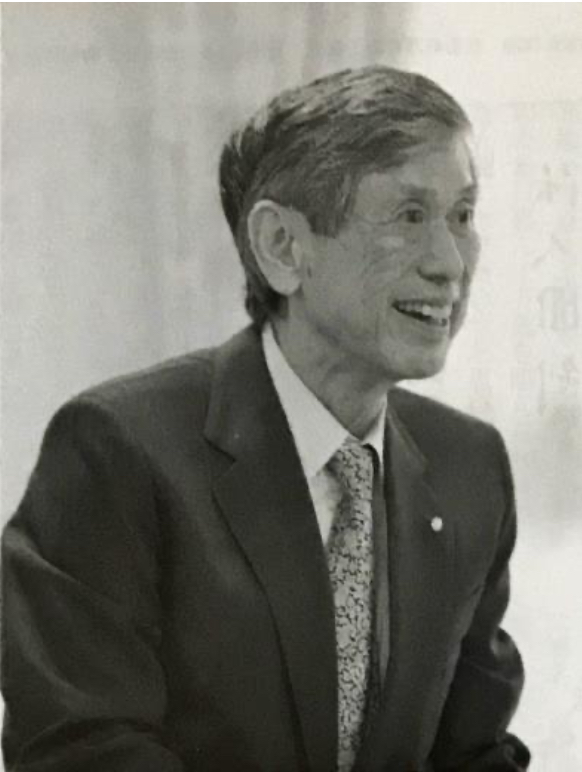
Otake Risuke Nippon Budōkan: Training and Teaching Everyday Over 90 Years of Age
Kōmura: I have heard much from you today. How is your daily life right now, Ōtake-sensei? I hear you are still practicing.
Ōtake: Yes. I am over 90, but as you can see, my back is straight and I still have all my teeth. I cannot thank my parents enough for this and still go to the Dōjō to train and teach daily.
Kōmura: That is truly amazing. You are a paragon as a martial artist. Ōtake: I am humbled to receive such words from you, Kōmura-sensei. Kōmura: Ōtake-sensei, what is your secret?Ōtake: I continue practicing everyday while being grateful.
Kōmura: To be able to do that is amazing in itself.
Ōtake: There is a piece of writing containing essential teachings called “Tenshin Shōden Katori Shintō-ryū Shinan-kata”. One excerpt reads “the student who wishes to learn about principles should be made to learn principles through the act of practice.” Basically, it advises one to teach principles to pedantic students through more practical means such as training. This also carries over to how a teacher should carry oneself. Only through acquiring proficiency through proper training can one’s words of instruction reach their student. This goes to show just how much ability the instructor must have. I believe it is the instructor themselves that are being tested.
I am grateful and highly treasure these peaceful days where I am able to continue training as I do now.
Kōmura: Indeed. I have visited many countries in my time as Minister for Foreign Affairs, but there are still many places where there just seems to be no end to conflict.
Ōtake: Now that I look back, nearly 77 years have passed since I joined the school when I was 16 years old in Shōwa 17 (1942). Those were turbulent times when we were thrown into the Pacific War. In June of Shōwa 20 (1945), I became a soldier in the Engineering Brigade of the Imperial Japanese Army, but the war ended soon after and I returned home. A lot has happened over the years, but training is the only thing I can be proud of for continuing to this day (laughs).
Kōmura: That is worthy of much praise. It is not something any ordinary person can accomplish.
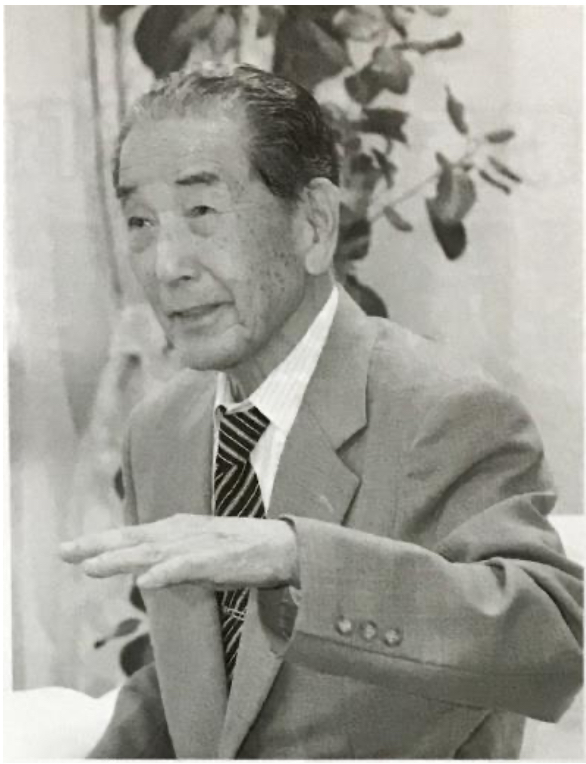
Otake Risuke Nippon Budōkan: A Lifetime of Walking the Righteous Path of Heaven and Earth
Kōmura: Lastly, Ōtake-sensei, can you please give our readers one final message?
Ōtake: Our lives at most last about 100 years. It is incomparable to the eternity of nature. One might even say our lives are but fleeting. Nonetheless, the fact that we have lived is everlasting. I believe that every action we take in our daily lives are not lost to time, and that they become part of a history that will be told for many generations to come. This is where I find meaning in striving to walk the righteous path of heaven and earth throughout one’s lifetime.
Kōmura: That was a pleasant story.
Ōtake: I think it is a miracle that some 600 years of offspring since the founder have upheld the teaching of ‘Heihō’ and continued to transmit the innermost teachings in this land of Katori. I believe it is my duty to continue training and improving myself further so that Katori Shintō-ryū may be passed down to future generations.
Kōmura: Truly marvellous words. Ōtake-sensei, I wish you continued health and prosperity.
Ōtake: As I have said in the beginning, I was worried about what to speak about after knowing I would be talking with you, Kōmura-sensei. I’m just a regular old man from the countryside, so I was very nervous about meeting with a great politician who is at the centre of the country and has met many important people from around the world. I’m not very good at speaking, so I wrote down what I thought I could talk about in a notebook. Also, please take a look at the Mokuroku scroll.
Kōmura: I see. This is a very valuable item. I look forward to reading it.
Ōtake: Thank you for inviting me here today. It was an honour to be able to speak with you, Kōmura-sensei.
Kōmura: There are many ancient cultures around the world, but traditions such as Katori Shintō-ryū that have been passed down for some 630 years unchanged to this day are few and far between. Scrolls of teachings, the written lineage, weapons and arms, not to mention the kata. Such treasures that transmit the tradition all remain to this date. I will further my efforts towards the preservation and promotion of Kobudō, including the designation of National Cultural Assets.
Thank you very much for today.
This is the end of the Otake Risuke Nippon Budōkan Interview.

